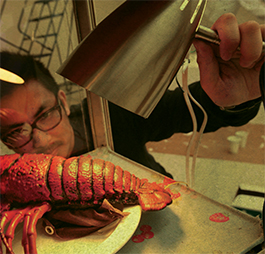Faculty Profile
Jim Kaste
 Our family moved from New Hampshire to Williamsburg in August of 2008, and I am very excited to be a part of the Environmental Science & Policy program here at William and Mary. The College and the community have been incredibly welcoming and supportive during my transition. In the fall, I taught Environmental Geochemistry, an upper-level course where we studied the processes that control the chemical composition of natural waters, specifically looking at rainfall, canopy throughfall, and stream waters. Precisely in the middle of the term, my wife, Heather, and I welcomed our first child, James, into the world, and as I write this, he turns five months old. So, my first year at W&M has begun with plenty of excitement. This spring I taught the upper-level course Environmental Geology and Introductory Geology (GEOL101) classes.
Our family moved from New Hampshire to Williamsburg in August of 2008, and I am very excited to be a part of the Environmental Science & Policy program here at William and Mary. The College and the community have been incredibly welcoming and supportive during my transition. In the fall, I taught Environmental Geochemistry, an upper-level course where we studied the processes that control the chemical composition of natural waters, specifically looking at rainfall, canopy throughfall, and stream waters. Precisely in the middle of the term, my wife, Heather, and I welcomed our first child, James, into the world, and as I write this, he turns five months old. So, my first year at W&M has begun with plenty of excitement. This spring I taught the upper-level course Environmental Geology and Introductory Geology (GEOL101) classes.
My research interests revolve around describing the fate of contaminants and sediments in watersheds. My Ph.D. dissertation and post-doctoral work focused on the deposition and fate of lead in soils of the northeastern U.S. and in Scandinavia. Lead is by far the most widely dispersed heavy-metal contaminant in the world, and I use Pb isotopes, selective chemical extractions, and x-ray studies to quantify its form and transport in watersheds. I am excited by the Mercury Global Inquiry Group ("HgGIG", check out mercury.wm.edu) at W&M, and am beginning some projects aimed at measuring Hg in soils and sediments. We will probably start with Lake Matoaka, which is one of the oldest mill ponds in the U.S., and has received Hg directly from atmospheric deposition and runoff for hundreds of years. One of my research specialties is sediment dating with 210Pb/226Ra disequilibria, which would enable us to work out the input chronology of mercury and other contaminants to the lake in our backyard.
I am particularly excited by the new collaborations that I am forming at W&M. Randy Chambers, Greg Hancock and I were recently awarded a grant from the Virginia Environmental Endowment to study the effective length of riparian buffers on agricultural lands draining to the James and York Rivers. The current regulation in Virginia that requires a minimum 100' forested buffer to filter sediments and contaminants from waterways was arbitrarily set decades ago. The water quality of the Chesapeake continues to decline, and agricultural lands appear to be major contributors of sediments to the Bay. Our hypothesis is that the standard 100' buffer is not universally adequate for filtering sediments and sediment-bound contaminants from surface waters. We have two students from the geology department, Eric Newman and Morgan Stumb, who will do their senior thesis work on this project starting this summer.
Stay tuned for further details, and I look forward to meeting new people and alumni from ENSP in the coming years!














